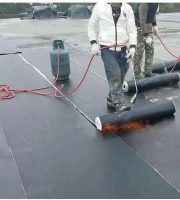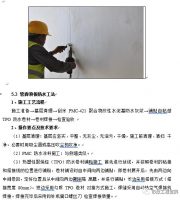Installation method of cable equipotential connection (2) equipotential connection of meter or valve.
Equipotential connection of metal pipes (a) single steel pipe; (b) Multiple parallel steel pipes (4) equipotential connection of metal conduit.
General equipotential connection plan (1) equipotential connection shall be made for the metal sheath of metal armored power cable, telephone cable, etc., and the protective sleeve passing through the wall into the house.
(3) equipotential bonding is beneficial to eliminate the interference of external electromagnetic field on internal electronic equipment within the protection range and improve the electromagnetic compatibility of electronic equipment.
The protective line used for equipotential connection is called equipotential connection line.
Each conductive object should be connected with each other for many times.
(1) total equipotential connection (MEB) total equipotential connection refers to the connection of PE trunk line, grounding trunk line of grounding electrode of electrical device, various metal pipes and metal components in the building, and the connection with grounding device to form equipotential connection.
The installation method of cable equipotential connection is shown in Figure 3.
Facilities requiring equipotential connection in the building shall be connected to the equipotential connection terminal board with connecting conductor or connected to the nearest grounding trunk line.
For buildings with a height of more than 20m, the connecting terminal board shall be connected with the down lead at a vertical interval of no more than 20m above the ground.
Figure 2 shows the general equipotential connection plan of the equipment floor of the building.
(3) equipotential connection of meters or valves (3) equipotential connection of metal pipes in buildings, metal doors and window frames equipped with metal shell exhaust fans and air conditioners, or metal doors and window frames close to power sockets, as well as metal railings, ceiling keels and other metal bodies within the arm extension range of exposed conductive parts shall be equipotential connected.
Schematic diagram of local equipotential connection schematic diagram of local equipotential connection ⑶ auxiliary equipotential connection (SEB) after the general equipotential connection of the building, some exposed conductive parts within the extension range and the conductive parts outside the device are additionally connected with wires to make the potential between them equal or closer, which is called auxiliary equipotential connection.
First fasten the round hoop with the metal outer sheath of the cable, and then 25mm × 4mm galvanized flat steel grounding main line welding.
The equipotential connection of metal conduit is shown in Figure 6, and the grounding warning signs are shown in Figure 7..
PE trunk lines, metal pipes of utilities, metal structures of buildings and other parts are connected with each other through local equipotential connection terminal boards.
Equipotential connection terminal board shall be installed at the position convenient for wiring in the distribution room, and shall be reliably connected with the grounding body at least two places through the grounding trunk line.
General equipotential bonding shall be implemented in high-rise buildings or buildings with grounding fault protection for electrical system.
The neutral point of transformer, neutral line (N line) of low-voltage power supply and distribution system and grounding protection line (PE line) of electrical equipment are directly connected to the main equipotential connection terminal board.
(2) equipotential connection can reduce the voltage between the metal shell of electrical equipment and other metal objects and the ground when electric leakage or grounding short circuit occurs in the electrical system, and reduce the risk of electric shock caused by electric leakage or short circuit.
The equipotential bonding method of metal pipes is shown in Figure 5.
Classification of equipotential bonding equipotential bonding is divided into total equipotential bonding (MEB), local equipotential bonding (LEB) and auxiliary equipotential bonding (SEB).
The total equipotential connection in the building is shown in Figure 1.
General equipotential connection diagram ⑵ local equipotential connection (LEB) local equipotential connection refers to connecting all exposed conductive parts that can be touched at the same time to form equipotential connection within a local range.
The protective casing shall be filled with waterproof ointment to prevent water leakage.
Equipotential bonding is to make reliable electrical connection between the metal frame, metal device, uncharged metal shell of electrical equipment and protective conductor of electrical system in the building and the grounding device.
For metal objects and electrical systems passing through different lightning protection boundaries or in the same lightning protection area, equipotential connection shall be made at the boundary.
Equipotential bonding wires or jumper wires of metal pipes can be welded, and those that cannot be welded shall be connected with pipe clamps.
The equipotential connection of the meter or valve is shown in Figure 4.
Function of equipotential connection ⑴ equipotential connection can reduce the potential difference between metal objects and protective conductors of electrical system in case of lightning stroke, and avoid fire, explosion, equipment damage and personal casualties caused by lightning.
Equipotential connection construction the general equipotential connection is generally set in the distribution room of the underground equipment floor.
Water supply pipe and gas pipe are usually equipped with meter or valve.
Auxiliary equipotential bonding must include all exposed conductive parts of fixed equipment that can be touched at the same time and conductive parts outside the device.
Other metal devices of non electrical system, such as elevator track, crane, metal floor, metal door frame, facility pipeline, cable bridge and other large-size metal objects, shall be connected to the nearest equipotential grounding trunk line or other metal objects with equipotential connection in the shortest path.
Local equipotential connection is required under the following circumstances: the impedance of the power network is too large, so that the automatic power cut-off time is too long, which can not meet the requirements of anti electric shock; TN system supplies power from the same distribution box to fixed and mobile electrical equipment, and the power cut-off time of fixed equipment protection appliances can not meet the anti electric shock requirements of mobile equipment; To meet the special requirements for electric shock prevention in bathrooms, swimming pools, hospital operating rooms, agriculture and animal husbandry and other places; In order to meet the requirements of lightning protection and anti-interference of information system.
Equipotential connection shall be made for distribution metal conduit, metal trunking, cable tray, etc.
During equipotential connection, jumper shall be made at the meter or valve, and the jumper can be 25mm × 4mm galvanized flat steel and 6mm2 copper core flexible strand can also be used.
warning signs shall be hung at the equipotential connection, which are made of white plastic and printed with red words.



